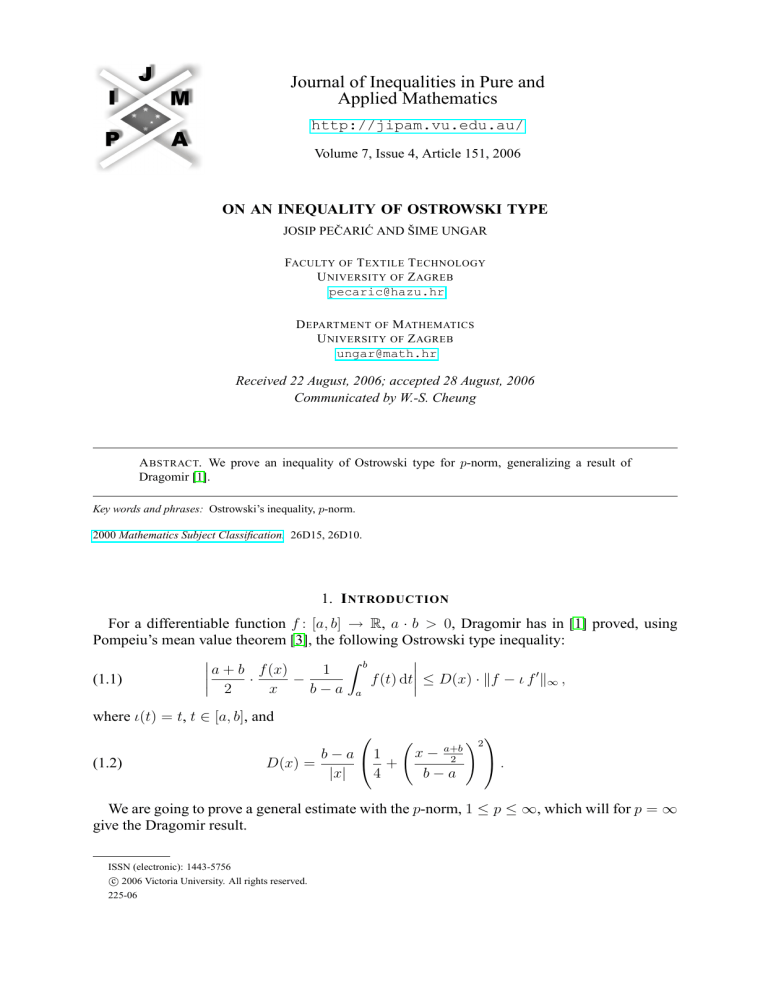
Journal of Inequalities in Pure and
Applied Mathematics
http://jipam.vu.edu.au/
Volume 7, Issue 4, Article 151, 2006
ON AN INEQUALITY OF OSTROWSKI TYPE
JOSIP PEČARIĆ AND ŠIME UNGAR
FACULTY OF T EXTILE T ECHNOLOGY
U NIVERSITY OF Z AGREB
pecaric@hazu.hr
D EPARTMENT OF M ATHEMATICS
U NIVERSITY OF Z AGREB
ungar@math.hr
Received 22 August, 2006; accepted 28 August, 2006
Communicated by W.-S. Cheung
A BSTRACT. We prove an inequality of Ostrowski type for p-norm, generalizing a result of
Dragomir [1].
Key words and phrases: Ostrowski’s inequality, p-norm.
2000 Mathematics Subject Classification. 26D15, 26D10.
1. I NTRODUCTION
For a differentiable function f : [a, b] → R, a · b > 0, Dragomir has in [1] proved, using
Pompeiu’s mean value theorem [3], the following Ostrowski type inequality:
Z b
a + b f (x)
1
(1.1)
·
−
f (t) dt ≤ D(x) · kf − ι f 0 k∞ ,
2
x
b−a a
where ι(t) = t, t ∈ [a, b], and
(1.2)
D(x) =
b − a 1
+
|x|
4
a+b
2
x−
b−a
!2
.
We are going to prove a general estimate with the p-norm, 1 ≤ p ≤ ∞, which will for p = ∞
give the Dragomir result.
ISSN (electronic): 1443-5756
c 2006 Victoria University. All rights reserved.
225-06
2
J OSIP P E ČARI Ć AND Š IME U NGAR
2. T HE M AIN R ESULT
Theorem 2.1. Let the function f : [a, b] → R be continuous on [a, b] and differentiable on (a, b)
with 0 < a < b. Then for p1 + 1q = 1, with 1 ≤ p, q ≤ ∞, and all x ∈ [a, b], the following
inequality holds:
Z b
1
a + b f (x)
(2.1)
·
−
f (t) dt ≤ P U (x, p) · kf − ι f 0 kp
2
x
b−a a
where ι(t) = t, t ∈ [a, b], and
(2.2) P U (x, p) = (b − a)
1
−1
p
"
·
1
x2−q − a1+q x1−2q q
a2−q − x2−q
+
(1 − 2q)(2 − q)
(1 − 2q)(1 + q)
2−q
1 #
b
− x2−q
x2−q − b1+q x1−2q q
+
+
.
(1 − 2q)(2 − q)
(1 − 2q)(1 + q)
Note that in cases (p, q) = (1, ∞), (∞, 1), and (2, 2) the constant P U (x, p) has to be taken
as the limit as p → 1, ∞, and 2, respectively.
Proof. Define F : [1/b, 1/a] → R by F (t) := t f ( 1t ). The function F is continuous and is
differentiable on (1/b, 1/a), and for all x1 , x2 ∈ [1/b, 1/a] we have
Z x1
F (x1 ) − F (x2 ) =
F 0 (t) dt
x
Z 2x1 1
1 0 1
1
(2.3)
=
f
− f
dt
u :=
t
t
t
t
x2
Z 1/x1
1
(2.4)
=−
(f (u) − uf 0 (u)) 2 du .
u
1/x2
Denote x1 =: 1/x and x2 =: 1/t. Then for all x, t ∈ [a, b] from (2.4) we get
Z t
1
1
1
f (x) − f (t) =
(f (u) − uf 0 (u)) 2 du,
x
t
u
x
i.e.,
Z
tf (x) − xf (t) = x t
(2.5)
x
t
(f (u) − uf 0 (u))
1
du .
u2
Integrating on t and dividing by x, we obtain
Z b
Z b Z t
b2 − a2 f (x)
1
0
·
−
f (t) dt =
t
(f (u) − uf (u)) 2 du dt ,
2
x
u
a
a
x
and therefore
(2.6)
Z b
b2 − a2 f (x)
·
−
f (t) dt
2
x
a
Z b Z t
t
≤
(f (u) − uf 0 (u)) 2 du dt
u
a
x
Z x Z x
Z b Z t
t
t
0
=
(f (u) − uf (u)) 2 du dt +
(f (u) − uf 0 (u)) 2 du dt .
u
u
a
t
x
x
J. Inequal. Pure and Appl. Math., 7(4) Art. 151, 2006
http://jipam.vu.edu.au/
O N AN I NEQUALITY
OF
O STROWSKI
3
TYPE
First, consider the case 1 < p, q < ∞. Applying Hölder’s inequality, the sum in the last line of
(2.5) is
Z x Z x
1q
p1 Z x Z x q
t
p
0
≤
(2.7)
|f (u) − uf (u)| du dt
·
du dt
2q
a
t
a
t u
1q
Z b Z t
p1 Z b Z t q
t
p
+
|f (u) − uf 0 (u)| du dt
du dt
·
2q
x
x
x
x u
p1
Z b Z b
p
≤
|f (u) − uf 0 (u)| du dt
a
a
" Z
x
Z
×
a
t
x
tq
du
u2q
1q Z b Z
+
dt
x
x
t
tq
du
u2q
1q #
.
dt
The first factor in (2.7) equals
Z b Z b
p1
1
p
(2.8)
|f (u) − uf 0 (u)| du dt
= (b − a) p kf − ι f 0 kp ,
a
a
and for the second factor, for p, q 6= 2, we get
Z
x
Z
x
(2.9)
a
t
tq
du
u2q
1q Z b Z
dt
+
x
=
t
x
tq
du
u2q
1q
dt
1
a
−x
x2−q − a1+q x1−2q q
+
(1 − 2q)(2 − q)
(1 − 2q)(1 + q)
2−q
1
b
− x2−q
x2−q − b1+q x1−2q q
+
+
.
(1 − 2q)(2 − q)
(1 − 2q)(1 + q)
2−q
2−q
Putting (2.8) and (2.9) into (2.7) and dividing (2.6) and (2.7) by (b − a) gives the required
inequality (2.1) in the case 1 < p, q < ∞, p, q 6= 2.
For p = q = 2, instead of (2.9) we obtain
Z
x
Z
(2.10)
a
t
x
t2
du
u4
12
t2
du dt
4
x
x u
12 21 !
3
3
3
3
x
x
a
b
ln
+ 3 −1
+ ln
+ 3 −1
a
x
b
x
12 Z b Z
dt
+
=
1
3
t
which is easily shown to be equal to the limit of the right hand side in (2.9) for q → 2, i. e.
12 12 !
x 3 a3
x 3 b3
1
ln
(2.11) lim P U (x, p) =
+ 3 −1
+ ln
+ 3 −1
.
1
p→2
a
x
b
x
3(b − a) 2
Now consider the case p = ∞, q = 1. The last line in (2.6) is
Z x Z x
Z b Z t
t
t
0
(2.12)
≤ sup |f (u) − u f (u)|
du dt +
du dt
2
2
a≤u≤b
a
t u
x
x u
2
a + b2
0
+x−a−b .
= kf − ι f k∞ ·
2x
J. Inequal. Pure and Appl. Math., 7(4) Art. 151, 2006
http://jipam.vu.edu.au/
4
J OSIP P E ČARI Ć AND Š IME U NGAR
Putting (2.12) into (2.6) and dividing by (b − a) gives
2
Z b
a + b f (x)
1
1
a + b2
·
−
f (t) dt ≤
+ x − a − b · kf − ι f 0 k∞
2
x
b−a a
b−a
2x
which reproves the Dragomir’s result [1].
It is easy to see that
2
a + b2
1
+ x − a − b = lim P U (x, p)
p→∞
b−a
2x
proving (2.1) in the case p = ∞, q = 1.
Finally consider the case p = 1, q = ∞. In this case the last line of (2.6) is
Z x Z x
t
(2.13)
≤
|f (u) − uf 0 (u)| max 2 du dt
t≤u≤x u
a
t
a≤t≤x
Z b Z t
t
+
|f (u) − uf 0 (u)| max 2 du dt
x≤u≤t u
x
x
x≤t≤b
Z bZ b
1
b
0
≤
|f (u) − u f (u)| du dt ·
+
a x2
a
a
1
b
= (b − a)
+
· kf − ι f 0 k1 .
a x2
Appending (2.13) to (2.6) and dividing by (b − a) gives
Z b
a + b f (x)
1
1
b
(2.14)
·
−
f (t) dt ≤
+
· kf − ι f 0 k1 .
2
x
b−a a
a x2
It is not too difficult to show that
1
b
(2.15)
lim P U (x, p) = + 2 ,
p→1
a x
so (2.14) proves formula (2.1) for p = 1, q = ∞, proving the theorem.
Remark 2.2. We have considered only the positive case, 0 < a < b. In the case a < b < 0,
a similar but more cumbersome formula holds, where most a’s, b’s and x’s have to be replaced
by their absolute values.
3. T HE W EIGHTED C ASE
In the weighted case we have the following result:
Theorem 3.1. Let the function f : [a, b] → R be continuous on [a, b] and differentiable on (a, b)
with 0 < a < b, and let w : [a, b] → R be a nonnegative integrable function. Then for p1 + 1q = 1,
with 1 ≤ p, q ≤ ∞, and all x ∈ [a, b], the following inequality holds:
Z
Z b
f (x) b
(3.1)
t w(t) dt −
f (t) w(t) dt
x a
a
"
1
1q
Z x
Z x
p
(b
−
a)
q
q
0
1−2q
q
1−q
x
t (w(t)) dt −
t
(w(t)) dt
≤ kf − ιf kp ·
1 ·
a
a
(1 − 2q) q
Z b
1q #
Z b
.
+
t1−q (w(t))q dt − x1−2q
tq (w(t))q dt
x
J. Inequal. Pure and Appl. Math., 7(4) Art. 151, 2006
x
http://jipam.vu.edu.au/
O N AN I NEQUALITY
OF
O STROWSKI
5
TYPE
Proof. Multiplying (2.5) by w(t)/x and integrating on t, we get
Z t
Z
Z b
Z b
f (x) b
1
0
t w(t) dt −
f (t) w(t) dt =
t w(t)
(f (u) − u f (u)) 2 du dt ,
x a
u
a
a
x
and as in the proof of Theorem 2.1 we have
Z
Z b
f (x) b
t w(t) dt −
f (t) w(t) dt
x a
a
Z b Z t
Z x Z x
t w(t)
t w(t)
0
≤
(f (u) − uf (u))
du dt +
(f (u) − uf 0 (u))
du dt
2
u
u2
a
t
x
x
Z x Z x
p1 Z x Z x q
1q
t (w(t))q
p
0
≤
|f (u) − u f (u)| du dt
·
du dt
u2q
a
t
a
t
Z b Z t
p1 Z b Z t q
1q
t (w(t))q
p
0
+
|f (u) − u f (u)| du dt
du dt
·
u2q
x
x
x
x
Z b Z b
p1
p
0
≤
|f (u) − u f (u)| du dt
a
a
" Z
x
Z
·
a
t
t (w(t))q
du
u2q
x q
1q Z b Z
dt
+
x
which gives (3.1).
x
t (w(t))q
du
u2q
t q
1q #
dt
R EFERENCES
[1] S.S. DRAGOMIR, An inequality of Ostrowski type via Pompeiu’s mean value theorem, J. of Inequal. in Pure and Appl. Math., 6(3) (2005), Art. 83. [ONLINE: http://jipam.vu.edu.au/
article.php?sid=532].
[2] A. OSTROWSKI, Über die Absolutabweichung einer differentienbaren Funktionen von ihren Integralmittelwert, Comment. Math. Hel., 10 (1938), 226–227.
[3] D. POMPEIU, Sur une proposition analogue au théorème des accroissements finis, Mathematica
(Cluj, Romania), 22 (1946), 143–146.
J. Inequal. Pure and Appl. Math., 7(4) Art. 151, 2006
http://jipam.vu.edu.au/

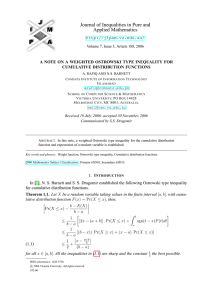
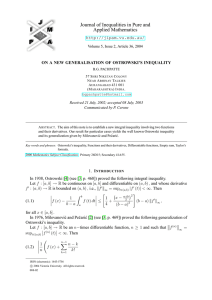
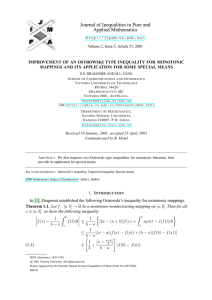
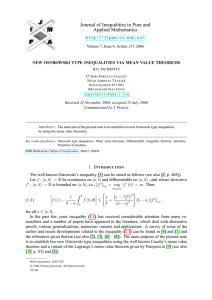




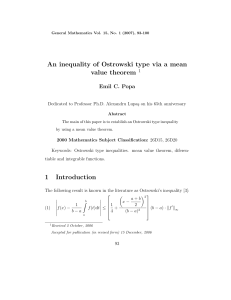

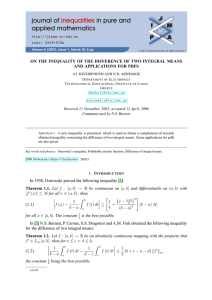
![ON THE WEIGHTED OSTROWSKI INEQUALITY I [5], (1.1)](http://s2.studylib.net/store/data/010717215_1-54ec7398ab903a21d10e53796295a83a-300x300.png)